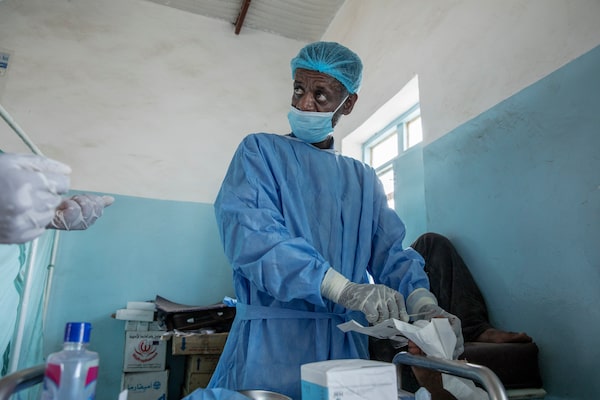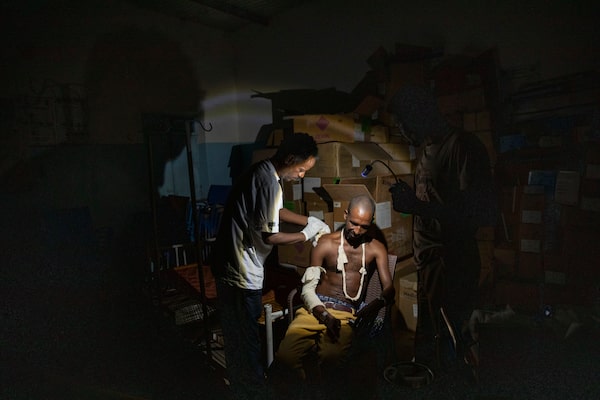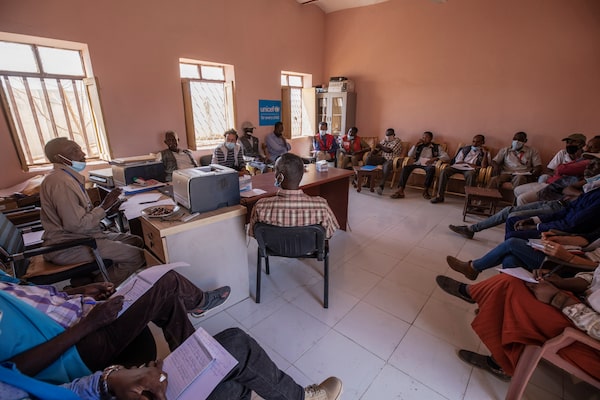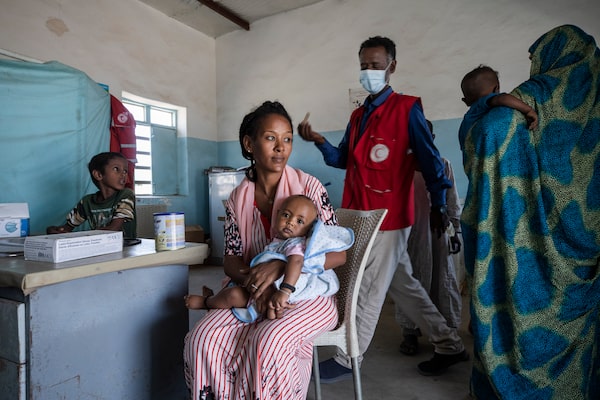
Dr. Tewodros Tefera performs surgery inside the Sudanese Red Crescent clinic in Hamdayet, eastern Sudan, on March 22, 2021.Nariman El-Mofty/The Associated Press
He is a surgeon and a father. Every morning, he wakes up under a plastic tarp and is reminded he’s now a refugee, too.
Tewodros Tefera is one of more than 60,000 people who have fled ethnic violence in Ethiopia’s northern Tigray region, crossing the border into a remote corner of Sudan. Horrified by what he saw when the fighting between Ethiopian and Tigray forces began six months ago, and by the tales of new arrivals, the 44-year-old chronicles the pain even as he treats it.
“It’s getting worse,” he says of life back home.
Ethiopia says it is “deeply dismayed” by the deaths of civilians, blames the now-fugitive Tigray leaders and claims normality is returning. But Dr. Tewodros’ patients tell him that killings, gang rapes and mass expulsions of ethnic Tigrayans continue as some six million civilians are targeted for their leaders’ political past.

Dr. Tefera is one of more than 60,000 people who have fled ethnic violence in Ethiopia's northern Tigray region.Nariman El-Mofty/The Associated Press
For Dr. Tewodros, it has not been a comfortable transformation from cool, detached doctor at one of Tigray’s largest hospitals to driven spokesman for his people. He used to write down reflections so emotional on the war and his new life that he later burned them.
“Ethiopia is dead to me,” he says, then corrects himself: “Ethiopia is dying.”
His wife and small children remain there, and he doesn’t know when he’ll see them again. They don’t know how raw his experience has been, and he hesitates to tell them. Once well-off, he arrived in Sudan with only the clothes he wore – jogging pants and a polo shirt – and his wedding ring.
He slept in the market his first few days in Sudan before introducing himself as a doctor and being welcomed.
The stresses have shaped him. He has lost weight, 12 kilograms (26 pounds), in the past five months, enough to worry his mother still inside Tigray. At times he closes his eyes and knocks a fist against his forehead, trying to drive back anxiety.
Dr. Tewodros now fills a growing number of notebooks as he compiles a “dossier” on the Tigray conflict. Sometimes he dreams of taking it to the International Criminal Court in a quest for justice.

NGO representatives hold a meeting focusing on Tigrayan refugees inside the Hamdayet Transition Center in eastern Sudan on March 22, 2021.Nariman El-Mofty/The Associated Press
He works from dawn to well beyond dusk at a clinic run by the Sudanese Red Crescent Society in the border community of Hamdayet. With no running water or electricity, he and a handful of colleagues see well over 100 patients a day. Dr. Tewodros has delivered babies and treated gunshot wounds, despite a shortage of anesthesia.
“He feels it as if he has the same pain,” one patient, Rahwa Haylay, says, her jaw still bandaged from an operation.
On a recent day, Dr. Tewodros examined the fresh welts on the back of a young man who had just walked in from Tigray. The man said he and his friends had been forced to lie in the hot sand and be beaten by soldiers from nearby Eritrea collaborating with Ethiopian forces. He heard one soldier call a superior and ask, “Should we kill them or let them go?”
Between patients, Dr. Tewodros is pulled aside by fellow refugees who seek his help with community matters, hushed confidences, legal questions. Meanwhile, he is picking up Arabic phrases to improve his treatment of local Sudanese. His exhaustion is kept at bay with cigarettes and coffee.
“This man, I think, is a special man,” said Yagoub Mohamed, the director of the local Sudanese reception centre for refugees. He and Dr. Tewodros meet daily to discuss their work but stray into the personal.
“When he talks about his wife and children, he’s crying,” Mr. Mohamed said.
At night, as Dr. Tewodros sits in the darkness outside the clinic and listens to the hum of thousands of refugees fade, he agonizes over the war. It troubles his sleep.
“It is definitely genocide,” he says. “If someone is being attacked for their identity, if they’re threatened to be vanished because of their identity, there is no other explanation for this.”
He believes that the killings are just the first step against the Tigrayans, with starvation the next. Already he has seen a number of severely malnourished people arrive.

Dr. Tefera has a growing number of notebooks as he compiles a 'dossier' on the Tigray conflict.Nariman El-Mofty/The Associated Press
Tigray remains largely cut off from the outside world by the Ethiopian government, with no internet access in most of the region.
“They are foolish to think the truth could be hidden forever,” Dr. Tewodros says.
Despite his criticism, he treated wounded soldiers for the Ethiopian government in the early hours of the conflict.
“A doctor is a doctor,” he says.
He would see 93 bodies in all, both combatants and civilians, before he fled, taking some wounded patients with him.
He plans to continue his work in Sudan. The high-rise buildings of his city in Tigray, Humera, can be seen on the horizon.
He could walk home, but he’s not sure he will ever go there again.
This story was funded by the Pulitzer Center on Crisis Reporting.
Our Morning Update and Evening Update newsletters are written by Globe editors, giving you a concise summary of the day’s most important headlines. Sign up today.